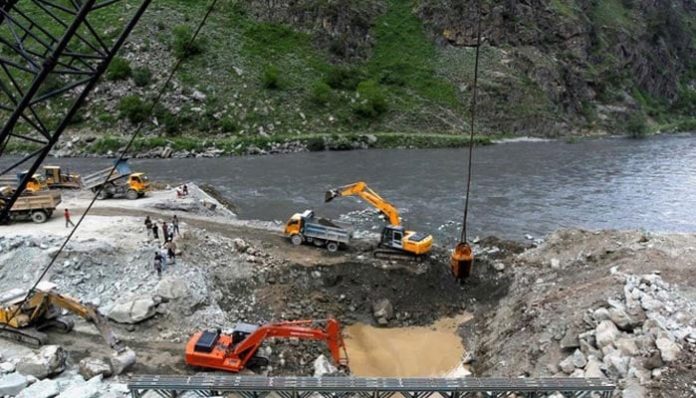—— India building two more controversial hydropower projects on Chenab River
—— Pakistan, India already battling over Ratle, Kishanganga projects
—— Kiru hydropower project is being built along the Chenab River
—— Pakistan objected to design of the Kiru hydropower project
News Desk
ISLAMABAD: India has started constructing two more controversial hydro projects – Kiru and Kwar — on the Chenab River with designs that are in sheer breach of the provisions of the Indus Waters Treaty (IWT) 1960, it has been reported on Thursday.
Islamabad and New Delhi are already in a legal battle in the court of arbitration and neutral expert, the two international forums on the faulty designs of 330MW Kishanganga and 850MW Ratle hydropower projects being built on Pakistan’s rivers.
Pakistan has objected to the designs of the Kiru hydropower project which has the capacity to gener-ate 624MW and the Kwar hydroelectric power project of 540MW in its recent interaction with India at the level of the Permanent Indus Waters Commission (PIWC). India is bound to share the designs of its projects with Pakistan under the Indus Waters Treaty.
The Kiru hydropower project is being built along the Chenab River near the villages of Patharnakki and Kiru, approximately 42kms from Kishtwar. It will be located between Kirthai-II hydroelectric project to its upstream and Kwar hydroelectric project to its downstream.
As per India, Kwar is a run-of-river project. The net head of the project will be 56.6 meters. The total number of penstocks, pipes or long channels that carry water down from the hydroelectric reservoir to the turbines inside the actual power station, is expected to be four in number. The penstock length will be 236 meters. The penstock diameter will be 5.65 meters. The project is expected to generate 1,975.54 GWh of electricity. The hydropower project consists of four turbines, each with 135MW nameplate capacity.
“Yes, India has shared with us some days back the designs of the two more projects that it is planning to construct on the Chenab river upstream Ratle hydropower project,” a senior official of Pakistan’s Commission of Indus Waters told.
“We have submitted our objections on the designs of both the projects on the components which in-clude spillways, freeboard, and pondages.”
“India is repeating the violations of the design-related provisions of the Indus Waters Treaty (IWT) 1960 in the designs of its projects despite Pakistan’s repeated objections. Similar faulty designs that have been adopted in the Kishanganga and Ratle projects are being repeated by India in more hydro-power projects on Pakistan’s rivers,” the official added.
Right now, both the countries are fighting a legal battle in the court of arbitration (CoA) and neutral expert (NE) in The Hague against the faulty designs of the Kishanganga project built on the Jhelum River and the Ratle project being constructed by India on the Chenab River.
Pakistan deems its case is very strong and if it wins in the court of arbitration and NE, then India would not be able to erect future projects on Pakistan’s rivers with designs violative of the IWT.
Coming to the Kiru project, as per Indian media, the 624MW Kiru hydroelectric project is being devel-oped as a run-of-river scheme in the Kishtwar district of Indian Illegally Occupied Jammu and Kashmir (IIOJK). The project is being developed by the Chenab Valley Power Projects (CVPPPL) joint venture (JV) between National Hydroelectric Power (NHPC, 51%) and Jammu & Kashmir State Power Devel-opment (JKSPDC, 49%).
The Indian Ministry of Environment Forests and Climate Change (MoEF&CC) awarded environmental clearance for the hydroelectric project in 2016, while the foundation stone was laid in February 2019.
The project is being constructed at an estimated cost of Rs42.88bn ($609.71m) and is expected to start commercial operations in July 2025. The Cabinet Committee on Economic Affairs (CCEA) approved the investment in the project in March 2019. The project will include the construction of a 135m-high con-crete gravity dam near Kiru.
A 700m-long, 9m-diameter horseshoe shape diversion tunnel with upstream and downstream coffer-dams is being created to divert the flow of the river to enable the dam construction. The flood control structures will include four orifice-type spillways and two crest spillways, which will serve the require-ments for flood release and reservoir flushing. Other major components of the project will include an underground powerhouse, four pressure shafts, and four tailrace tunnels.
The powerhouse will be located on the left bank of the river near Kiru. The powerhouse cavern will be 182m-long, 23.6m-wide, and 51.2m-high. It will include four vertical Francis turbines, each with a power generating capacity of 156MW, with a rated head of 117.98 meters.
A 137m-long, 17m-wide, and 15m-high transformer-cum-draft tube gate cavern will also be created as part of the powerhouse complex. The four pressure shafts will have an internal diameter of 5.5 meters and lengths ranging between 316 meters and 322 meters. The horseshoe-shaped concrete-lined tail-race tunnels will have a diameter of 7 meters and lengths ranging from 165 meters to 190 meters.




